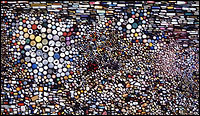Archives
Chinese Maximalism debuts
UB is only U.S. venue for groundbreaking art exhibition
By KRISTIN E.M. RIEMER
Reporter Contributor
The UB Art Gallery in the Center for the Arts will be the only U.S. venue for "Chinese Maximalism, a groundbreaking exhibition of more than 65 works by 15 contemporary Chinese artists that is the result of an unprecedented collaboration between the UB Art Gallery and the Millennium Museum in Beijing, China.
The exhibition, which is free and open to the public, will be on view at the UB Art Gallery Oct. 18 through Jan. 31.

“Red Children,” a 2003 installation by Gu Dexin, is part of the exhibition “Chinese Maximalism,” which will open to the general public on Oct. 18 in the UB Art Gallery in the Center for the Arts, North Campus.
Curated by Gao Minglu, assistant professor in the UB Department of Art History and a leading authority on Chinese art in the 20th and 21st centuries, "Chinese Maximalism" is the first exhibition organized to address the concept of "maximalism," a term recently coined by Gao to distinguish this body of Chinese contemporary art.
The exhibition presents a wide range of works in various mediums by such Chinese artists as Cao Kai, Ding Yi, Gu Dexin, Hong Hao, Lei Hong, Li Huasheng, Qin Yufen, Shen Fan, Song Tao, Wu Yiming, Xing Danwen, Xu Hongmin, Yang Zhenzhong, Zhu Jinshi and Zhu Xiaohe.
Visitors to the exhibition will find that the works on view share a visual resonance with Western minimalism: soft lines, grids and repetition abound. Beyond this, however, distinctive Chinese aesthetics set the artwork apart from minimalism. In contrast to minimalist artists, who focus on the distillation of form and color, Chinese maximalist artists combine cultural practices and historical traditions with the act of art-making.
Chinese maximalism "emphasizes the spiritual experience of the artist in the process of creation as a self-contemplation outside and beyond the artwork itself," Gao says. "The material existence of the work is perhaps best understood as a record of this spiritual experience. These artists," he continues, "pay more attention to the process of creation and the uncertainty of meaning and instability in a work. Meaning is not reflected directly in a work because they believe that what is in the artist's mind at the moment of creation may not necessarily appear in his work."

“My Things No. 5,” a 2002 photograph by Hong Hao, is one of the more than 65 works by 15 contemporary artists that make up “Chinese Maximalism.”
Sandra H. Olsen, director of the UB Art Galleries, elaborates on this concept with an account of her trip to Beijing last March for the exhibition's premiere at the Millennium Museum in Beijing. The UB Art Gallery is the only other venue for this two-stop exhibition.
"My understanding of the concept of maximalism was enhanced as I watched elderly Chinese men practicing the art of calligraphy on the city's sidewalks," Olsen recalls. "They were using water. As each brushstroke was applied, the one before it disappeared. It was the process that held meaning to them as they struggled to maintain a dying cultural practice."
"Chinese Maximalism" will serve as a prelude to a second exhibition of Chinese contemporary art that is scheduled to travel to Buffalo from Beijing in October 2005. In collaboration with the Millennium Museum, UB Art Galleries and the Albright-Knox Art Gallery, "The Wall" is a large-scale exhibition that will be shown at three Buffalo venues. Also curated by Gao, who is best known for his exhibition "Inside Out" at the San Francisco Museum of Modern Art in 1998, "The Wall" is an innovative, multidisciplinary project focused on the concept of the "wall" in Chinese history.
A private preview reception for "Chinese Maximalism" will be held at 7 p.m. Oct. 17 for all ticket holders to "Excerpts from the Chinese Beijing Opera 'The Monkey Knows No Walls'" at the Center for the Arts. (See brief on page 3 for details on "The Monkey Knows No Walls")
To coincide with the opening of "Chinese Maximalism," the Asian Studies Program in the College of Arts and Sciences will host the annual meeting of the New York Conference on Asian Studies (NCYAS) Oct. 17-18. Some 200 faculty and graduate students from colleges and universities across New York State and the surrounding region will listen to research papers and plenary speakers on a variety of topics related to East Asia, Southeast Asia, South Asia and Asia-America. The conference theme, "Walls in Asia," was selected as a prelude to the upcoming "The Wall" exhibition. For more information about the conference, visit http://wings.buffalo.edu/asian/NYCAS03.
"Chinese Maximalism" is sponsored by WBFO 88.7 FM, the National Public Radio affiliate operated by UB; the UB Asian Studies Program and the 2003 New York Conference on Asian Studies.
The UB Art Gallery is supported, in part, by The Visual Arts Building Fund, The Seymour H. Knox Foundation Fine Arts Fund and The Fine Arts Center Endowment.
The UB Art Gallery is open from 11 a.m. to 6 p.m. Tuesday through Saturday.
For information call 645-6912.
